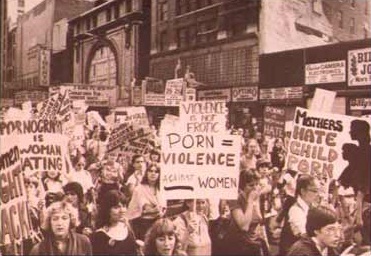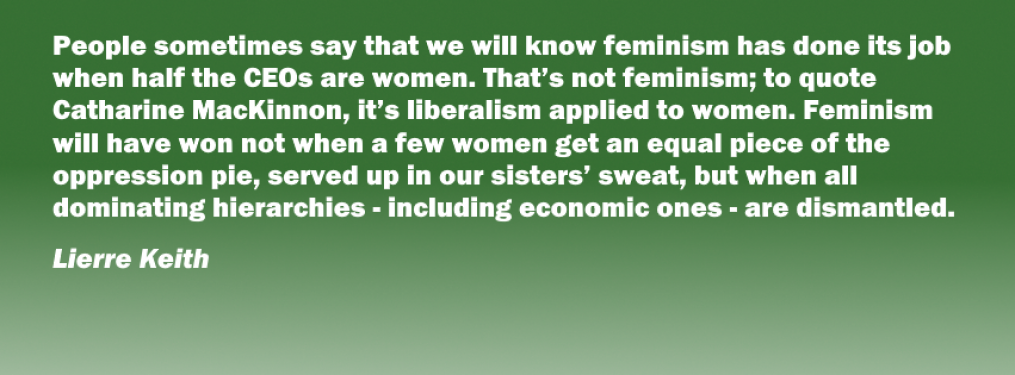Rebecca Whisnant / Sexualization, Media, & Society

For over two decades now, I have taught, written, and spoken publicly about pornography from a feminist perspective. In the 1990s, the most common critical questions I received involved censorship and the law. In recent years, the focus has changed: when there are critical questions, they most often concern feminist pornography. What about it? Does it exist? Could it exist? Do I, or would I, object to it? What is it like, or what could it be like?
I do not find the ‘‘what-if’’ and ‘‘could-there-be’’ questions particularly illuminating, nor am I skilled at prognosticating what media forms might exist in possible postpatriarchal futures. Furthermore, as in discussions of pornography generally, sometimes people are motivated to defend ‘‘feminist pornography’’ in the abstract while knowing little to nothing about the actual material in question. Thus, it seems more fruitful to bring the discussion down to cases: that is, to investigate what some of those who claim to be making feminist pornography are actually making, and what they are saying about what they are making. People can then judge for themselves whether that material reflects a sexual ethic, and a conception of feminism, that they wish to endorse.
Case Study: Tristan Taormino
This article focuses on one self-described feminist pornographer who looms large in the contemporary ‘‘sex-positive’’ and ‘‘sex radical’’ firmament. Tristan Taormino first came to prominence in the late 1990s and early 2000s as, among other things, editor of the lesbian porn magazine On Our Backs and a sex columnist for the Village Voice. In 1999, she collaborated with mainstream pornographer John Stagliano and fetish porn producer Ernest Greene on The Ultimate Guide to Anal Sex for Women, a porn film based on her book of the same title. In more recent years, Taormino’s porn productions have included the Chemistry series, the Rough Sex series, and Tristan Taormino’s Expert Guides to various sexual acts.
Author, speaker, educator, editor, TV host, filmmaker, and more: when it comes to the various self-styled sex-positive movements, venues, and endeavors of roughly the last twenty years, Taormino has done it all, and she has been at the center of much of it. The variety and reach of Taormino’s work illustrates that, as Comella (2013) observes, ‘‘Feminist pornography is not a series of stand-alone texts that exist outside of a much wider cultural context—and history—of sex-positive feminist cultural production and commerce’’ (p. 91).
In addition to being prominent, Taormino is intelligent, reflective, and articulate about the choices she has made and about the politics and assumptions underlying those choices. Furthermore, her body of work exemplifies themes and commitments that are largely consistent among those who produce, perform in, and/or support feminist pornography.
My discussion is based partly on Taormino’s published writings and interviews as well as on an admittedly small selection of her films—one full-length and several extended clips. While I see no reason to believe that the selections I viewed are unrepresentative of her film work as a whole, readers should take into account that my critique is based on a limited sampling of that work.
As will quickly become evident, Taormino’s feminist politics are different from my own, and my take on her work is a critical one. My aim is not to write a hit piece, however, but rather to articulate clearly the political and ethical worldview that underlies Taormino’s body of work—thus, again, enabling more informed discussions of feminist pornography and related issues.
‘‘An Industry Within an Industry’’
Feminist critics of pornography frequently emphasize that, whatever else it may be, contemporary pornography is above all an industry within a capitalist marketplace. As Jensen (2007) points out, ‘‘the DVDs and internet sites to which men are masturbating are not being made by struggling artists who work in lonely garrets, tirelessly working to help us understand the mysteries of sexuality’’ (p. 79). Even once we understand that mainstream pornography is driven by profit, we may tend to assume that feminist pornography emerges from utopian enclaves, where people produce exactly what they want to
produce based on their own unique, creative, and egalitarian visions of sex.
Of course, no such enclaves exist, or if they do, then few people will ever see whatever erotic materials are created therein. As Taormino, Parreñas-Shimuzu, Penley, and Miller-Young (2013) write in their introduction to The Feminist Porn Book,
feminist porn is not only an emergent social movement and an alternative cultural production: it is a genre of media made for profit. Part of a multibillion dollar business in adult entertainment media, feminist porn is an industry within an industry. (pp. 15–16)
In a 2014 interview, Taormino comments further that
In the United States there is not necessarily a clear, discrete division between ‘‘feminist/queer/indie porn’’ and ‘‘mainstream porn’’… . I situate my own work in both worlds: I make feminist pornography that is funded and distributed by mainstream companies and features primarily mainstream performers. (Voss, 2014, p. 204)
In fact, perhaps more than any other figure, Taormino has occupied and helped to shape both mainstream and alternative spaces within the sex industry—as evidenced by, among other things, her having repeatedly won both Adult Video News awards and Feminist Porn awards.
Taormino is well aware of the trade-offs attendant on working with mainstream porn companies and reaching mainstream audiences. As she puts it in the 2003 documentary Hot and Bothered, ‘‘Funding is always an issue… . people always ask why isn’t there more feminist porn, why there isn’t more lesbian porn, and the truth is, you need money’’ (Goldberg, 2003). She continues,
I basically had two different ways to go. I could try the feminist way, which is that you beg, borrow, and steal, you do it on a shoestring, you ask all your friends to do stuff for free, and then you try to distribute it yourself. Or, I could go directly to the man and sell out, and go to a mainstream adult company, where I would have to compromise some of my, like, artistic integrity. (Goldberg, 2003)
Indeed, one can only be so critical of mainstream porn if that is the venue within which one works and within which one hopes to maintain friendly ties and funding sources. Similarly, one can only diverge so far from the tropes of mainstream porn while still appealing to any reasonable subset of its consumer base.
Like all pornography, and indeed all media, feminist pornography can be analyzed in terms of its production, its content, and its consumption (Jensen, 2007); and when media is produced and sold within a capitalist marketplace, such analysis must keep a clear eye on how each dimension is shaped by the
imperatives of profit.

References
Comella, L. (2013). From text to context: Feminist porn and the making
of a market. In T. Taormino, C. Parren˜as-Shimuzu, C. Penley, & M.
Miller-Young (Eds.), The feminist porn book: The politics of producing
pleasure (pp. 79–93). New York, NY: The Feminist Press.
Goldberg, B. (Director). (2003). Hot and bothered: Feminist pornography
[Film]. U.S.: National Film Network.
Jensen, R. (2007). Getting off: Pornography and the end of masculinity.
Cambridge, MA: South End Press.
Taormino, T., Parreñas-Shimuzu, C., Penley, C., & Miller-Young, M.
(2013). Introduction: The politics of producing pleasure. The feminist
porn book: The politics of producing pleasure (pp. 9–20).
New York, NY: Feminist Press.
(Excerpted from ‘‘But What About Feminist Porn?’’: Examining the Work of Tristan Taormino)
